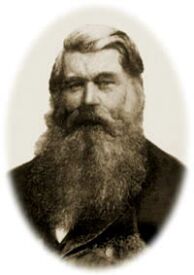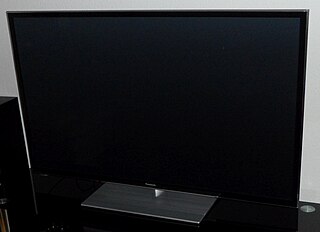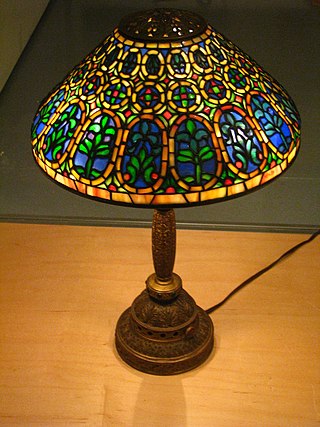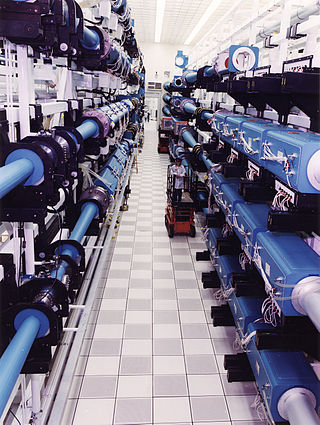Related Research Articles

Joseph Ritter von Fraunhofer was a German physicist and optical lens manufacturer. He made optical glass, an achromatic telescope, and objective lenses. He developed diffraction grating and also invented the spectroscope. In 1814, he discovered and studied the dark absorption lines in the spectrum of the sun now known as Fraunhofer lines.

Sir Joseph Wilson Swan FRS was an English physicist, chemist, and inventor. He is known as an independent early developer of a successful incandescent light bulb, and is the person responsible for developing and supplying the first incandescent lights used to illuminate homes and public buildings, including the Savoy Theatre, London, in 1881.

A plasma display panel is a type of flat-panel display that uses small cells containing plasma: ionized gas that responds to electric fields. Plasma televisions were the first large flat-panel displays to be released to the public.

A neon lamp is a miniature gas-discharge lamp. The lamp typically consists of a small glass capsule that contains a mixture of neon and other gases at a low pressure and two electrodes. When sufficient voltage is applied and sufficient current is supplied between the electrodes, the lamp produces an orange glow discharge. The glowing portion in the lamp is a thin region near the cathode; the larger and much longer neon signs are also glow discharges, but they use the positive column which is not present in the ordinary neon lamp. Neon glow lamps were widely used as indicator lamps in the displays of electronic instruments and appliances. They are still sometimes used for their electrical simplicity in high-voltage circuits.

In the signage industry, neon signs are electric signs lighted by long luminous gas-discharge tubes that contain rarefied neon or other gases. They are the most common use for neon lighting, which was first demonstrated in a modern form in December 1910 by Georges Claude at the Paris Motor Show. While they are used worldwide, neon signs were popular in the United States from about the 1920s to 1950s. The installations in Times Square, many originally designed by Douglas Leigh, were famed, and there were nearly 2,000 small shops producing neon signs by 1940. In addition to signage, neon lighting is used frequently by artists and architects, and in plasma display panels and televisions. The signage industry has declined in the past several decades, and cities are now concerned with preserving and restoring their antique neon signs.

A plasma ball, plasma globe, or plasma lamp is a clear glass container filled with noble gases, usually a mixture of neon, krypton, and xenon, that has a high-voltage electrode in the center of the container. When voltage is applied, a plasma is formed within the container. Plasma filaments extend from the inner electrode to the outer glass insulator, giving the appearance of multiple constant beams of colored light. Plasma balls were popular as novelty items in the 1980s.

A Geissler tube is a precursor to modern gas discharge tubes, demonstrating the principles of electrical glow discharge, akin to contemporary neon lights, and central to the discovery of the electron. This device was developed in 1857 by Heinrich Geissler, a German physicist and glassblower. A Geissler tube is composed of a sealed glass cylinder of various shapes, which is partially evacuated and equipped with a metal electrode at each end. It contains rarefied gases—such as neon or argon, air, mercury vapor, or other conductive substances, and sometimes ionizable minerals or metals like sodium. When a high voltage is applied between the electrodes, there is an electric current through the tube, causing gas molecules to ionize by shedding electrons. The free electrons reunite with the ions and the resulting energic atoms emit light via fluorescence, with the emitted color characteristic of the contained material.

Neon lighting consists of brightly glowing, electrified glass tubes or bulbs that contain rarefied neon or other gases. Neon lights are a type of cold cathode gas-discharge light. A neon tube is a sealed glass tube with a metal electrode at each end, filled with one of a number of gases at low pressure. A high potential of several thousand volts applied to the electrodes ionizes the gas in the tube, causing it to emit colored light. The color of the light depends on the gas in the tube. Neon lights were named for neon, a noble gas which gives off a popular orange light, but other gases and chemicals called phosphors are used to produce other colors, such as hydrogen (purple-red), helium, carbon dioxide (white), and mercury (blue). Neon tubes can be fabricated in curving artistic shapes, to form letters or pictures. They are mainly used to make dramatic, multicolored glowing signage for advertising, called neon signs, which were popular from the 1920s to 1960s and again in the 1980s.

A Tiffany lamp is a type of lamp made of glass and shade designed by Louis Comfort Tiffany or artisans, mostly women, and made in his design studio. The glass in the lampshades is put together with the copper-foil technique instead of leaded, the classic technique for stained-glass windows. Tiffany lamps are considered part of the Art Nouveau movement. Considerable numbers of designs were produced from 1893 onwards.

Nova was a high-power laser built at the Lawrence Livermore National Laboratory (LLNL) in California, United States, in 1984 which conducted advanced inertial confinement fusion (ICF) experiments until its dismantling in 1999. Nova was the first ICF experiment built with the intention of reaching "ignition", the condition where self heating of the fusion plasma exceeds all losses. Although Nova failed in this goal, the data it generated clearly defined the problem as being mostly a result of Rayleigh–Taylor instability, leading to the design of the National Ignition Facility, Nova's successor. Nova also generated considerable amounts of data on high-density matter physics, regardless of the lack of ignition, which is useful both in fusion power and nuclear weapons research.
In nonlinear optics, filament propagation is propagation of a beam of light through a medium without diffraction. This is possible because the Kerr effect causes an index of refraction change in the medium, resulting in self-focusing of the beam.

The MIT Museum, founded in 1971, is part of the Massachusetts Institute of Technology in Cambridge, Massachusetts. It hosts collections of holography, technology-related artworks, artificial intelligence, architecture, robotics, maritime history, and the history of MIT. Its holography collection of 1800 pieces is the largest in the world, though only a few selections from it are usually exhibited. As of 2023, works by the kinetic artist Arthur Ganson were the largest long-running displays; in 2024 they were replaced by a newer art installation, but some of Ganson's works were reinstalled elsewhere in the museum. There is a regular program of temporary special exhibitions, often on the intersections of art and technology.

The Rochester Museum & Science Center (RMSC) is a museum in Rochester, New York, dedicated to community education in science, technology and local history. The museum also operates the Strasenburgh Planetarium, located next to the museum, and the Cumming Nature Center, a 900-acre (3.6 km2) nature preserve near Naples, New York. The museum resides at 657 East Ave. and has a collection of 1.2 million artifacts.

Narinder Singh Kapany was an Indian-American physicist best known for his work on fiber optics. Kapany is a pioneer in the field of fiber optics, known for coining and popularising the term. Fortune named him one of seven "Unsung Heroes of the 20th Century" for his Nobel Prize-deserving invention. He was awarded India's second highest civilian award, the Padma Vibhushan, posthumously in 2021. He served as an Indian Ordnance Factories Service (IOFS) officer. He was also offered the post of Scientific Adviser to the Defence Minister of India, by the first Prime Minister of India, Jawaharlal Nehru. He is considered the father of Fiber Optics.

Stephen Anthony Benton was the inventor of the rainbow hologram and a pioneer in medical imaging and fine arts holography. Benton held 14 patents in optical physics and photography, and taught media arts and sciences at Massachusetts Institute of Technology (MIT). He was the E. Rudge ('48) and Nancy Allen Professor of Media & Sciences, and the Director for Center for Advanced Visual Studies (CAVS) at MIT.
Bryan-Gooding Planetarium in the Alexander Brest Science Theatre is a planetarium in the Museum of Science and History in Jacksonville, Florida, U.S. It was built in 1988 and featured a 60-foot-diameter (18 m) dome-shaped projection screen, JBL stereo sound system, and a Zeiss Jena Optical mechanical planetarium star projector. The facility has seating for 200, and approximately 60,000 people see a planetarium show each year.

The Exploratorium is a museum of science, technology, and arts in San Francisco, California. Founded by physicist and educator Frank Oppenheimer in 1969, the museum was originally located in the Palace of Fine Arts and was relocated in 2013 to Piers 15 and 17 on San Francisco's waterfront.
G. Michael Morris was president of the Optical Society of America in 2002.
Physics outreach encompasses facets of science outreach and physics education, and a variety of activities by schools, research institutes, universities, clubs and institutions such as science museums aimed at broadening the audience for and awareness and understanding of physics. While the general public may sometimes be the focus of such activities, physics outreach often centers on developing and providing resources and making presentations to students, educators in other disciplines, and in some cases researchers within different areas of physics.
Kenneth Brecher is an American professor of astronomy and physics, emeritus at Boston University, with a focus on high-energy astrophysics, relativity, and cosmology. His wife, Aviva Brecher, is also a physicist.
References
- ↑ Gache, Gabriel (January 31, 2008), "How do Plasma Lamps Work", Softpedia
- 1 2 Wolf, Lauren (October 27, 2008), "Plasma Globes: Inert gases and electricity combine to generate colored streamers of light", Chemical & Engineering News.
- ↑ The Artists-In-Residence Program at the Exploratorium.
- ↑ AM Lightning by Bill Parker Archived December 21, 2008, at the Wayback Machine , The Exploratorium.
- ↑ Cole, K. C. (July 9, 1978), "San Francisco's Scientific Fun House", The New York Times .
- ↑ "On The Town", The Tech , September 2, 1994.
- ↑ Davis, William A. (February 1, 1997), "Hi-Tech Hijinks: The MIT Museum Makes Science Into Family Fun", The Boston Globe .
- ↑ Malina, Roger (June 1995), "Exhibit Review: MIT Museum Holograms", Leonardo Electronic Almanac, 3 (6).
- ↑ "See how far an idea can go", OpenDoor: the Arts, MIT Alumni Association, February 2001, archived from the original on March 20, 2008.
- ↑ Funke, Phyllis (April 7, 1974), "Science Is Blended With Art in Display", The New York Times.
- ↑ Raynor, Vivien (January 12, 1992), "Sculpture Show Fills the Housatonic Museum's New Gallery", The New York Times.
- ↑ Exhibit artists – Bill Parker Archived December 21, 2008, at the Wayback Machine , The Exploratorium.
- ↑ "And now, son of Lava Lamp", Miami Herald , November 10, 1984
- ↑ "Playthings meant for grownups", The Philadelphia Inquirer , November 7, 1986.
- 1 2 Vermont Inventor Offers Leahy Panel Advice On Patent Reform Archived December 17, 2008, at the Wayback Machine , U.S. Senator Patrick Leahy, April 25, 2005.
- 1 2 Pellett, Dorothy (September 10, 2007), "Invention is the soul of Creative MicroSystems", Burlington Free Press , archived from the original on January 18, 2013.
- ↑ "O'Gara Group Makes Second Acquisition In Optics Area", Defense Daily, May 31, 2005.
- ↑ "Parker runs for select board in Waitsfield", Valley Reporter, February 14, 2008.
- ↑ Town of Waitsfield, Vermont – Select Board Archived February 14, 2009, at the Wayback Machine . Retrieved December 18, 2008.